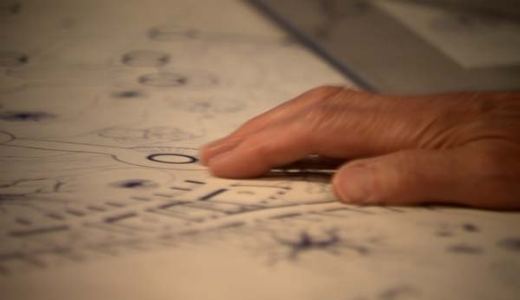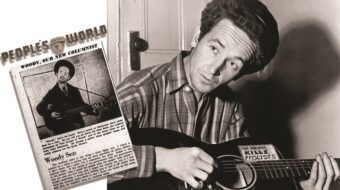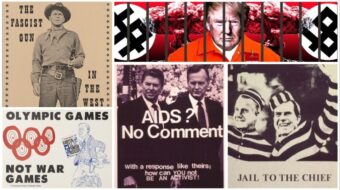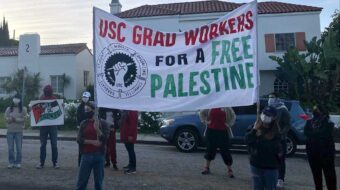
This is the first of a series about the 2011 Los Angeles Film Festival.
The Los Angeles Film Festival is currently taking place (mostly) in Downtown Los Angeles through June 26, and this year’s multitude of movies includes: “International Spotlight: Cuba.” Four Cuban features and documentaries will be screened during the film fiesta, which is one of L.A’s annual cultural treasures, presenting a wide array of films, from studio blockbusters such as Green Lantern to indies, foreign films, documentaries, shorts, etc. Complementing, but actually separate from this year’s spotlight on Cuban cinema, is the world premiere of Unfinished Spaces, which is actually entered in LAFF’s “Documentary Competition” and made by the Yanqui filmmakers Alysa Nahmias and Benjamin Murray.
Unfinished Spaces is the amazing true story of the ongoing struggle to build the Cuban National Arts Schools. According to the doc, the idea for the schools emerged shortly after the revolution, when Commandantes Fidel Castro and Che Guevara showed up unannounced at Havana’s most posh country club to play a round of golf, the sport of the idle rich. While on the manicured links a light bulb was illuminated above Fidel’s head, and, full of revolutionary zeal, he decided that instead of being an aristocratic preserve for the high and mighty, the country club should be transformed into not one, but five schools of the arts – theater, dance, painting, music, etc. – that would train a new generation of artists to give shape to and express the revolution. “Cuba will count as having the most beautiful academy of arts in the world,” Fidel declared in 1961.
While Che and Fidel drove back from the country club through Havana, they saw a prominent female architect and had their car pulled over. She was recruited on the spot to help find architects to design the new facility, and the impulsive, impatient Fidel, fresh from the Sierra Madre and eager to transform all of society, gave them two months to create the blueprints for the ambitious Cuban National Arts Schools.
Half a century later, that school, dreamt up by Fidel, remains to be completed, and its trial and tribulations have been tied to the ebbs and flows of the Cuban Revolution. The three architects – the Cuban Ricardo Porro and the Italian transplants Vittorio Garatti and Roberto Gottardi – envisioned avante garde forms in order to literally give shape to Castro’s commission and to the Revolution itself. However, this emphasis on style fell out of favor as “formalism” was eschewed and Cuba grew increasingly allied with the Soviet Union, in favor of the Stalinist style architecture, which emphasized function instead of aesthetics. Of course, economics played a role, and during periods of hardship funding was cut for the schools. Most recently, hurricanes halted construction and restoration efforts.
Nevertheless, throughout its ups and downs, the schools have trained generations of Cuban artists, even as the jungle threatened to reclaim the campuses and turn the site into something similar to ancient ruins. Castro’s personal role in the development of the schools is intriguing, and late in the film Fidel surprisingly reappears.
Unfinished Spaces examines the role of the revolutionary artist in the Revolution. It is something of a cautionary tale: In the heady early days of revolutions, flush with Promethean victory, anything seems possible. Towards the beginning of the doc we see Fidel, Che and the guerrillas triumphantly enter Havana, and there’s the sense that a new millennium will be ushered in. But revolutions, alas, have their Thermidors, their setbacks and even reversals. The saga of the schools and of the architects who designed them reflects this process.
At the world premiere of Unfinished Spaces in the Regal Cinemas at L.A. LIVE, the three companeros were reunited, and after seeing the finished film for the first time, the architects participated in a Q&A session in the packed theatre. Although they are now senior citizens, they called to mind the Soviet poet Vladimir Mayakovsky’s saying: “There’s no grey hair in my soul.”
As part of its International Spotlight series, LAFF is also screening a feature about (and made on location in) Cuba, co-writer/director Fina Torres’ sexy comedy with liberal doses of magical realism, Habana Eva. The Venezuela-born Torres is quite an accomplished filmmaker, who previously made the 2000 Penelope Cruz pic Woman on Top, 1995’s Celestial Clockwork and 1985’s Oriana. Habana Eva is the tale of Eva (Prakriti Maduro), a Cuban seamstress who has her designs on becoming a haute couture fashion designer, but her entrepreneurial flair and initiative is stifled by a factory bureaucrat in this parable of the dilemmas facing contemporary Cuba under Raul – not Fidel – Castro. Eva is wooed by two lovers – one of them representing Cuban socialism, the other, a Cuban born photographer who lives in Venezuela, symbolizing bourgeois values. Eva’s amusing choice is a prophecy of Cuba’s current move away from socialist economic orthodoxy, and a far cry from the revolutionary zeal of Humberto Solas’ famed 1968 Cuban feminist film, Lucia.
Like Polynesian vahines (women), Cuban muchachas were famed for their beauty and sensuality, and Cuban women epitomized the silver screen stereotypes of those “hot Latin lovers.” In Habana Eva, Torres seems to be toying with these torrid tropical tropes. But, ideology aside, the problem with this movie is that Eva’s friend Teresa (Yuliet Cruz) outshines her in all of the scenes they appear in together. Teresa is simply sexier, prettier, funnier and more likable and vivacious than Eva (spoiler alert: even when she’s dead and becomes a Fellini-esque Yuliet of the spirits!). Cruz simply steals every scene in which she graces the screen with her appearance. When she’s offscreen, viewers may make that Shakespearian pleading: “Wherefore art thou Yuliet?” To top matters off, Yuliet Cruz is actually Cuban, while Prakriti Maduro is Venezuelan. The comparison between the two is similar to comparing Natalie Wood as Maria and Rita Moreno as Anita in West Side Story. But this is a quibble; Habana Eva is a rollicking sex farce with great location shooting in Cuba, charmingly sprinkled with magical realist (not socialist realist!) motion picture pixie dust.
The other films in the series spotlighting Cuba are the documentary Operation Peter Pan: Flying Back To Cuba; Suite Habana and the feature Ticket To Paradise, set during Cuba’s “special period” following the collapse the Soviet Union.
For show times, venues, tickets and other LAFF information, visit the festival website.
Photo: Vittorio Garatti with a drawing of the Escuela de Musica, 2005, via the Unfinished Spaces website.












Comments